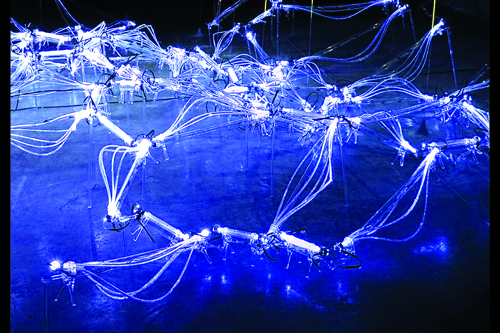Professor Mark-David Hosale set to debut the Quasar 2.0
Emilia Vieni
Contributor

York professor Mark-David Hosale will debut his digital media and fine arts project this year at Toronto’s annual dawn-till-dusk contemporary arts festival, Nuit Blanche.
His project, the “Quasar 2.0: Star Incubator,” is the result of a collaboration between Hosale and Jean Michael Crettez, an architect from Los Angeles.
The Quasar 2.0 is a sound and light installation designed to simulate the human cycle of life.
With data collected from several observatories in Antarctica, the work presents light patterns depending on what is going on in the atmosphere at any given moment. Think of it as a fibre optic light that changes colours, and the colour changes all depend on what kind of data are picked up from the observatory stations.
Weather changes and electromagnetic fields are the two main external factors affecting the Quasar 2.0.
“The best way to think of it is as a medium, as it does not react on its own, but rather on what it receives from Antarctica,” says Hosale.
But there is far more to the Quasar 2.0 than a pretty display
of colours.
The name “Quasar” actually comes from some of the brightest stars in the galaxy, many of which date back to the Big Bang theory.
“Poetically, the whole idea of the project is that we are affected by these ancient stars, and through our medium, the Quasar 2.0, we are able to expressively connect to the limits of our horizon,” explains Hosale.
During Nuit Blanche, the Quasar 2.0 will be a part of “The Museum for the End of the World” exhibition, located in the parking garage of Nathan Phillips Square.
The Quasar 2.0 was planned over the course of two years, built in two weeks by Hosale’s students under his instruction.
It consists of three layers: first, aluminum loops that create a support structure for the skeleton.
Second, a layer made from polycarbonic tubes and acrylic joints that give it its unique shape.
Third, a layer consisting of fibre optic “flesh” that is lit up by full-colour LEDs.
Not only does the Quasar 2.0 react to data collected from the observatory stations, but the gallery in which it will be displayed will be outfitted with sensors that will react to the movement of audience members in the exhibition, which will result in a spectacular light pattern.
The “Quasar 2.0: Star Incubator” reminds us all of how everything is interconnected.
Even events we think are long past will always have some sort of effect on us, even if it’s as small as a dust particle. The universe has no bounds in the past, present, or future.


